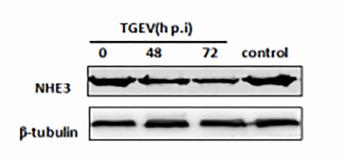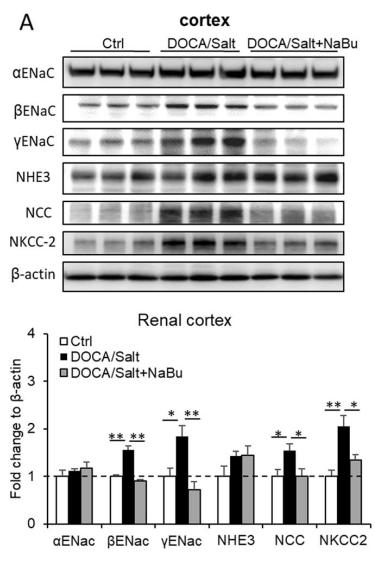NHE-3 Antibody - #DF9937
| Product: | NHE-3 Antibody |
| Catalog: | DF9937 |
| Description: | Rabbit polyclonal antibody to NHE-3 |
| Application: | WB |
| Cited expt.: | WB |
| Reactivity: | Human, Mouse, Rat |
| Prediction: | Pig, Bovine, Horse, Sheep, Rabbit, Dog, Chicken |
| Mol.Wt.: | 93kDa; 93kD(Calculated). |
| Uniprot: | P48764 |
| RRID: | AB_2843131 |
Product Info
*The optimal dilutions should be determined by the end user. For optimal experimental results, antibody reuse is not recommended.
*Tips:
WB: For western blot detection of denatured protein samples. IHC: For immunohistochemical detection of paraffin sections (IHC-p) or frozen sections (IHC-f) of tissue samples. IF/ICC: For immunofluorescence detection of cell samples. ELISA(peptide): For ELISA detection of antigenic peptide.
Cite Format: Affinity Biosciences Cat# DF9937, RRID:AB_2843131.
Fold/Unfold
MGC126718; MGC126720; Na(+)/H(+) exchanger 3; NHE 3; NHE-3; NHE3; SL9A3_HUMAN; SLC9A 3; Slc9a3; Sodium/hydrogen exchanger 3; Sodium/hydrogen exchanger, apical epithelial; Solute carrier family 9 (sodium/hydrogen exchanger), isoform 3; Solute carrier family 9 (sodium/hydrogen exchanger), member 3; Solute carrier family 9 member 3;
Immunogens
A synthesized peptide derived from human NHE-3, corresponding to a region within the internal amino acids.
- P48764 SL9A3_HUMAN:
- Protein BLAST With
- NCBI/
- ExPASy/
- Uniprot
MWGLGARGPDRGLLLALALGGLARAGGVEVEPGGAHGESGGFQVVTFEWAHVQDPYVIALWILVASLAKIGFHLSHKVTSVVPESALLIVLGLVLGGIVWAADHIASFTLTPTVFFFYLLPPIVLDAGYFMPNRLFFGNLGTILLYAVVGTVWNAATTGLSLYGVFLSGLMGDLQIGLLDFLLFGSLMAAVDPVAVLAVFEEVHVNEVLFIIVFGESLLNDAVTVVLYNVFESFVALGGDNVTGVDCVKGIVSFFVVSLGGTLVGVVFAFLLSLVTRFTKHVRIIEPGFVFIISYLSYLTSEMLSLSAILAITFCGICCQKYVKANISEQSATTVRYTMKMLASSAETIIFMFLGISAVNPFIWTWNTAFVLLTLVFISVYRAIGVVLQTWLLNRYRMVQLEPIDQVVLSYGGLRGAVAFALVVLLDGDKVKEKNLFVSTTIIVVFFTVIFQGLTIKPLVQWLKVKRSEHREPRLNEKLHGRAFDHILSAIEDISGQIGHNYLRDKWSHFDRKFLSRVLMRRSAQKSRDRILNVFHELNLKDAISYVAEGERRGSLAFIRSPSTDNVVNVDFTPRSSTVEASVSYLLRENVSAVCLDMQSLEQRRRSIRDAEDMVTHHTLQQYLYKPRQEYKHLYSRHELTPTEDEKQDREIFHRTMRKRLESFKSTKLGLNQNKKAAKLYKRERAQKRRNSSIPNGKLPMESPAQNFTIKEKDLELSDTEEPPNYDEEMSGGIEFLASVTKDTASDSPAGIDNPVFSPDEALDRSLLARLPPWLSPGETVVPSQRARTQIPYSPGTFCRLMPFRLSSKSVDSFLQADGPEERPPAALPESTHM
Predictions
Score>80(red) has high confidence and is suggested to be used for WB detection. *The prediction model is mainly based on the alignment of immunogen sequences, the results are for reference only, not as the basis of quality assurance.
High(score>80) Medium(80>score>50) Low(score<50) No confidence
Research Backgrounds
Involved in pH regulation to eliminate acids generated by active metabolism or to counter adverse environmental conditions. Major proton extruding system driven by the inward sodium ion chemical gradient. Plays an important role in signal transduction.
Phosphorylated by PKA, which inhibits activity. Phosphorylation at Ser-663 by SGK1 is associated with increased abundance at the cell membrane.
Apical cell membrane>Multi-pass membrane protein.
Note: In intestinal epithelial cells, localizes to the ileal brush border. Phosphorylation at Ser-663 by SGK1 is associated with increased abundance at the cell membrane. Angiotensin-2 enhances apical expression (By similarity).
Belongs to the monovalent cation:proton antiporter 1 (CPA1) transporter (TC 2.A.36) family.
Research Fields
· Organismal Systems > Excretory system > Proximal tubule bicarbonate reclamation.
· Organismal Systems > Digestive system > Protein digestion and absorption.
· Organismal Systems > Digestive system > Mineral absorption.
References
Application: WB Species: pig Sample: IPEC-J2 cells
Application: WB Species: rat Sample: renal cortex and medulla
Restrictive clause
Affinity Biosciences tests all products strictly. Citations are provided as a resource for additional applications that have not been validated by Affinity Biosciences. Please choose the appropriate format for each application and consult Materials and Methods sections for additional details about the use of any product in these publications.
For Research Use Only.
Not for use in diagnostic or therapeutic procedures. Not for resale. Not for distribution without written consent. Affinity Biosciences will not be held responsible for patent infringement or other violations that may occur with the use of our products. Affinity Biosciences, Affinity Biosciences Logo and all other trademarks are the property of Affinity Biosciences LTD.

